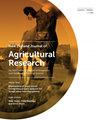在澳大利亚夏季主要降雨区,秋季播种的温带一年生硬种子豆科植物在热带草地上比春季播种的豆科植物生长得更好
IF 1.5
3区 农林科学
Q2 AGRICULTURE, MULTIDISCIPLINARY
New Zealand Journal of Agricultural Research
Pub Date : 2023-11-01
DOI:10.1080/00288233.2023.2274395
引用次数: 0
摘要
摘要温带一年生豆科植物可作为热带多年生牧草的有效伴生种。这些豆科植物通常在秋季播种,之后是草的建立。然而,在播种之前建立种子库可能更有效,或者可能在春季播种热带草地时将豆类作为硬种子/豆荚播种。在新南威尔士州北部进行了一项研究,比较了三种硬种子豆科植物:膀胱三叶草(Trifolium spumosum) cv。Bartolo, biserrula pelecinus) cv。Casbah和法国serradella (sativus Ornithopus) 5。Margurita。豆科植物播种了四次:一到两个秋天,然后是指草(Digitaria eriantha) cv。首期立草,秋季立草后播种或与立草同时播种,要么为硬籽/荚果段,要么为结籽(共5个处理)。虽然季节条件影响建立成功,秋季是播种温带一年生豆科植物的最佳时间,以实现高产的混合牧场。豆科植物可在植草前或植草后1-2个秋季播种。豆科植物春播硬粒/荚段种群数量低于秋播,但次年增加。关键词:双播,夏播,硬粒破碎,热带牧场,夏季优势雨区。作者感谢Geoff Bevan, Peter Sanson和Ivan Stace的技术支持。此外,作者感谢Belinda Hackney博士对豆类品种和播种率提供的建议,Angelo Loi博士对结果的讨论,以及Bernie Dominiak博士对本手稿早期版本的反馈。作者还感谢马尼拉的Robert和Lea Bowman ' Bonnie Doon '为本研究提供了场地。披露声明作者未报告潜在的利益冲突。本研究由澳大利亚肉类和畜牧业协会资助,项目编号为B. PSP.0001。本文章由计算机程序翻译,如有差异,请以英文原文为准。
Hard-seeded temperate annual legumes establish better in a tropical grass pasture when autumn-sown than spring-sown in a summer dominant rainfall zone, Australia
ABSTRACTTemperate annual legumes can be effective companion species in tropical perennial grass pastures. These legumes are commonly sown in autumn following establishment of the grasses. However, it may be more effective to establish a seed bank before sowing the grass, or possibly sow the legumes as hard seed/pod in spring when the tropical grass pasture is sown. A study was conducted in northern New South Wales to compare establishment, regeneration and productivity of three hard-seeded legumes: bladder clover (Trifolium spumosum) cv. Bartolo, biserrula (Biserrula pelecinus) cv. Casbah and French serradella (Ornithopus sativus) cv. Margurita. The legumes were sown four times: either one or two autumns before digit grass (Digitaria eriantha) cv. Premier was established, the autumn following grass establishment or sown at the same time as the grass as either hard seed/pod segments or scarified seed (total of five treatments). While seasonal conditions influenced establishment success, autumn was the optimal time to sow temperate annual legumes to achieve a productive mixed pasture. The legumes can be sown 1–2 autumns before or in the autumn following grass establishment. Legume plant populations of spring sown hard seed/pod segments were lower than those autumn sown but they increased the following year.KEYWORDS: Twin sowing, summer sowing, hard seed breakdown, tropical pasture, summer dominant rainfall zone AcknowledgementsThe authors appreciate the technical support provided by Geoff Bevan, Peter Sanson and Ivan Stace. Additionally, the authors appreciate advice provided by Dr Belinda Hackney on legume species and sowing rates, Dr Angelo Loi for discussion on results, and feedback from Dr Bernie Dominiak on an earlier version of this manuscript. The authors also thank Robert and Lea Bowman ‘Bonnie Doon’, Manilla for providing the site to conduct this study.Disclosure statementNo potential conflict of interest was reported by the author(s).Additional informationFundingThis work was supported by Meat and Livestock Australia under grant B. PSP.0001.
求助全文
通过发布文献求助,成功后即可免费获取论文全文。
去求助
来源期刊
CiteScore
4.90
自引率
16.70%
发文量
31
审稿时长
3 months
期刊介绍:
The New Zealand Journal of Agricultural Research publishes original research papers, review papers, short communications, book reviews, letters, and forum articles. We welcome submissions on all aspects of animal and pastoral science relevant to temperate and subtropical regions. The journal''s subject matter includes soil science, fertilisers, insect pests, plant pathology, weeds, forage crops, management systems, agricultural economics, agronomy, and animal science. The journal also accepts crossover papers on subjects such as land –water interactions.

 求助内容:
求助内容: 应助结果提醒方式:
应助结果提醒方式:


